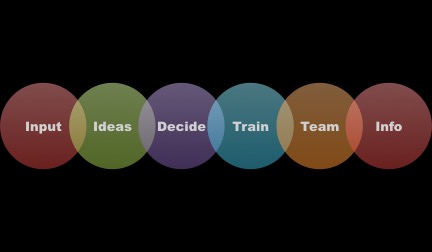Meeting Types
Meeting Types Matter
Be sure to identify the type of meeting you need before you schedule, pick the process, create the agenda, or invite people to attend. This sounds simply and straight forward, but think about how many times a meeting is called and scheduled before anyone’s thought about this–let alone shared the goal. Don’t do those things until you’ve figured this out. When I use this model with my clients they clarify and focus their work and their meetings are both more productive and effective.
Tip: Determine the meeting type based on your purpose and what you need from attendees. People participate differently depending on the meeting type. Set expectations to elicit engagement. (Coming soon: Meeting Roles)
There are 6 basic meeting types. Some meetings combine more than one type if the purpose requires more than one type of work. The processes you use in a meeting should align with the type of work you need to accomplish.
1. Getting INPUT: Do you need information about challenges or solutions team members have? Looking to brainstorm ideas for new products, services, or programs? Wondering about project progress or team priorities? Want feedback about a recent event? Meet to gather input. Let folks know the questions in advance, and ask them to reflect beforehand and bring their best thinking.
2. Generating IDEAS/Expanding Thinking: Facing a sticky problem? Struggling to determine the best course of action? Need to gain a multi-faceted perspective? Want to hear different points of view? Meet to expand the group’s thinking. Let folks know the topics in advance, and ask them to think about and share their own insights, questions, and understanding.
3. Making DECISIONS: Standing at a crossroads? Facing a change? Determining which improvements need to be made? Planning and need to select what to stop, start, or continue? Meet to decide. Let folks know that’s the purpose, and always let them know who the decision-makers are, and how the decision will be made in advance. Note: If you’ll be discussing but not deciding and a different group or individual will make a decision later, this is NOT a decision-making meeting. Be sure to make that clear to manage expectations.
4. TRAINING/Learning: Rolling out a new software system? Launching a new program? Trying to change your organizational culture, processes, or procedures? Need to shift team members’ habits and behaviors? Meet to train. Let folks know what’s coming. Be sure to share materials in advance and afterwards. Provide content in ways that match different learning styles. Remember: Training is a skill-building and learning process, and face-to-face training is often a critically important component, but shouldn’t be the only one.
5. TEAM-Building: Bringing new staff on board? Struggling with unproductive conflict? Getting ready to restructure? Composing a new team or wanting to energize an existing one? Meet to team-build. Let participants know your intentions. In some workplaces team-building has a bad rep: some dismiss it as “touchy feely.” But the research tells us that the highest performing teams have cohesion and trust, and task accomplishment is only one ingredient that creates these bonds. Make sure you select exercises tha fit your organization and are relevant to your team.
6. INFO Sharing: Making an announcement? Want to share a decision with everyone at once? Need teams to provide each other with the same information? Looking to dispel rumors or clarify confusion? Meet to share information. Let folks know they’re attending to be informed. There’s nothing worse than coming to a meeting expecting to be able to give feedback, help make a decision, or share ideas when a decision’s been made or a change is about to be implemented.
I guarantee your meetings will be more productive if you identify the meeting type(s) before you:
- Schedule
- Pick the process
- Create the agenda
- Invite participants
TIP: Try this simple way to remember the 6 types: IIDTTIA.
This model is based on the powerful work of Sam Kaner, author of Facilitator’s Guide to Participatory Decision-Making.

